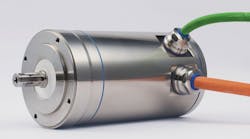Servo Motors Designed to Bridge the Precision and Hygiene Requirements of Regulated Industries
Key Highlights
- AKMH's stainless steel construction with BISSC, FDA, NSF and EHEDG certifications eliminates motor bagging during washdowns, saving maintenance time and directly improving overall equipment effectiveness (OEE).
- AKMA's anodized aluminum housing delivers 10-15% better performance than stainless steel alternatives at 30-40% lower cost while maintaining IP69K rating for rigorous cleaning protocols.
- Rounded housing geometry and engineered surface finishes prevent liquid pooling and bacterial buildup, reducing recall risks under FSMA regulations while withstanding high-pressure, caustic chemical washdowns.
Manufacturers across industry know that servo motors are the precision workhorses that keep automated operations running smoothly. These rotary actuators, which combine motors with position feedback sensors and servo drives, enable the exact angular control essential for applications ranging from filling and packaging to mixing and general material handling applications.
But in food, beverage and pharmaceutical manufacturing, precision is only half the battle. Hygiene, cleanability and regulatory compliance are equally critical.
Servo motors that can address regulated production requirements such as the Food Safety Modernization Act (FSMA) are critical to manufacturers because the FSMA grants federal authorities the power to shut down facilities, recall products and impose substantial fines when food safety is compromised.
These requirements are the reason Regal Rexnord developed its AKMA and AKMH servo motor series. At Pack Expo 2025, Automation World spoke with Jonathan Crumpler, product manager at Kollmorgen, a brand of Regal Rexnord, to get more insight into these servo motor lines.
The AKMH stainless steel servo motor
Designed for applications with direct food contact and in splash zones, the AKMH series is constructed from stainless steel. These motors meet IP69K, EHEDG and 3A standards while using FDA-approved, food-grade materials throughout.
"This servo motor comes with a BISSC (Baking Industry Sanitation Standards Committee) certification as well as FDA approval and NSF (National Science Foundation) certification. These certifications mean our customers don't have to get those regulatory body approvals on their own," explained Crumpler.
The AKMA is about 30 to 40% less expensive than the stainless-steel option. It still carries IP69K capability for washdown needs, but without that full level of stainless steel with its higher-grade certifications.
The AKMH's design philosophy centers on eliminating bacterial harboring points. Flat surfaces, cracks and crevices — all potential contamination sites — have been engineered out of the design. The rounded housing ensures liquids don't pool but instead run off during cleaning cycles.
This attention to surface geometry, combined with an EHEDG-certified surface finish, means manufacturers can use the servo motor “through the rigorous washdown cycles without having to bag the motors," Crumpler added. Eliminating motor bagging alone saves considerable time during cleaning cycles, directly contributing to improved uptime and OEE.
The AKMH housing and cabling can also withstand daily exposure to high-pressure, high-temperature and caustic chemical washdowns with no other protective guards or covers required.
Available in frame sizes 2 through 6, the AKMH series delivers continuous power output up to 5.5 kilowatts and continuous torque up to 21.5 Newton meters (Nm).
Crumpler noted that standard aluminum-housed servo motors can offer 10-15% better performance compared to stainless steel servos due to their material properties, but the AKMH's capabilities are suitable for a wide range of food processing applications where sanitary design is non-negotiable.
AKMA servos for washdown environments
For applications outside direct food contact zones, the AKMA series was developed. Its hardened anodized aluminum coating provides resistance to chemicals across a wide pH range, standing up to common cleaning agents without the becoming vulnerable to scrapes, dents and flaking associated with conventional epoxy coatings on servo motors.
Eliminating motor bagging alone saves considerable time during cleaning cycles, directly contributing to improved uptime and OEE.
The 316L stainless steel shaft of the AKMA features a chromium oxide inlay that maximizes seal lifetime, while the vented, one-piece housing design eliminates O-rings that could allow for water ingress.
"The anodized aluminum housing on AKMA gives users about 10 to 15% better performance on average versus stainless steel," Crumpler explained. That means you could potentially use a smaller motor, depending on the needs of the application, or get more power out of a similar size motor compared to a stainless-steel variation.
Cost is another consideration for users, said Crumpler: "The AKMA is about 30 to 40% less expensive than the stainless-steel option. It still carries IP69K capability for washdown needs, but without that full level of stainless steel with its higher-grade certifications."
Like the AKMH, the AKMA incorporates a smooth surface and round housing to prevent contamination pooling. Available in four frame sizes, it delivers continuous torque from 0.5 Nm to 14.5 Nm with peak torque ranging from 1.4 Nm to 38 Nm.
Cabling and seal details that matter
Both the AKMA and AKMH series of servos have features that reduce maintenance and improve reliability. For example, the AKMA's stainless steel hybrid connector with integrated Viton seal enables single-cable connection to the servo drive to simplify installation and reduce failure points.
"Having a single cable for power, data and feedback means there’s only one cable you have to route through your machine. If you accidentally damage that cable, you don't have to replace the whole motor or multiple cables," Crumpler noted. "We've also designed a passive ventilation system, so there's a vent on the bottom as well as a seal around the connector. What that means is, as you're going through the thermal cycling of the motor, you get longer term reliability because the speed at which a breakdown of the motor — caused by temperature and pressure that expands and contracts inside of the motor — is reduced."
The video below features Jonathan Crumpler showcasing the highlights of the AKMA and AKMH series of servo motors.
More motor and motion control insights from Automation World:
About the Author
David Greenfield, editor in chief
Editor in Chief

Leaders relevant to this article:
